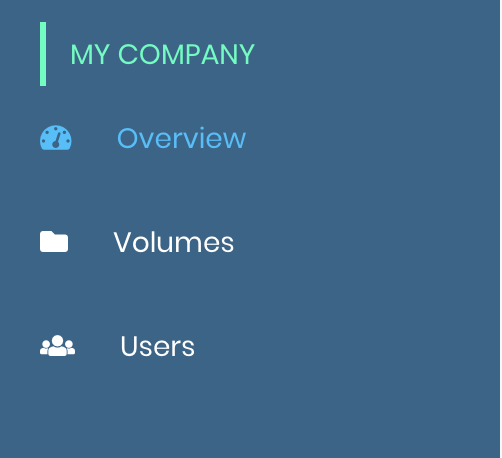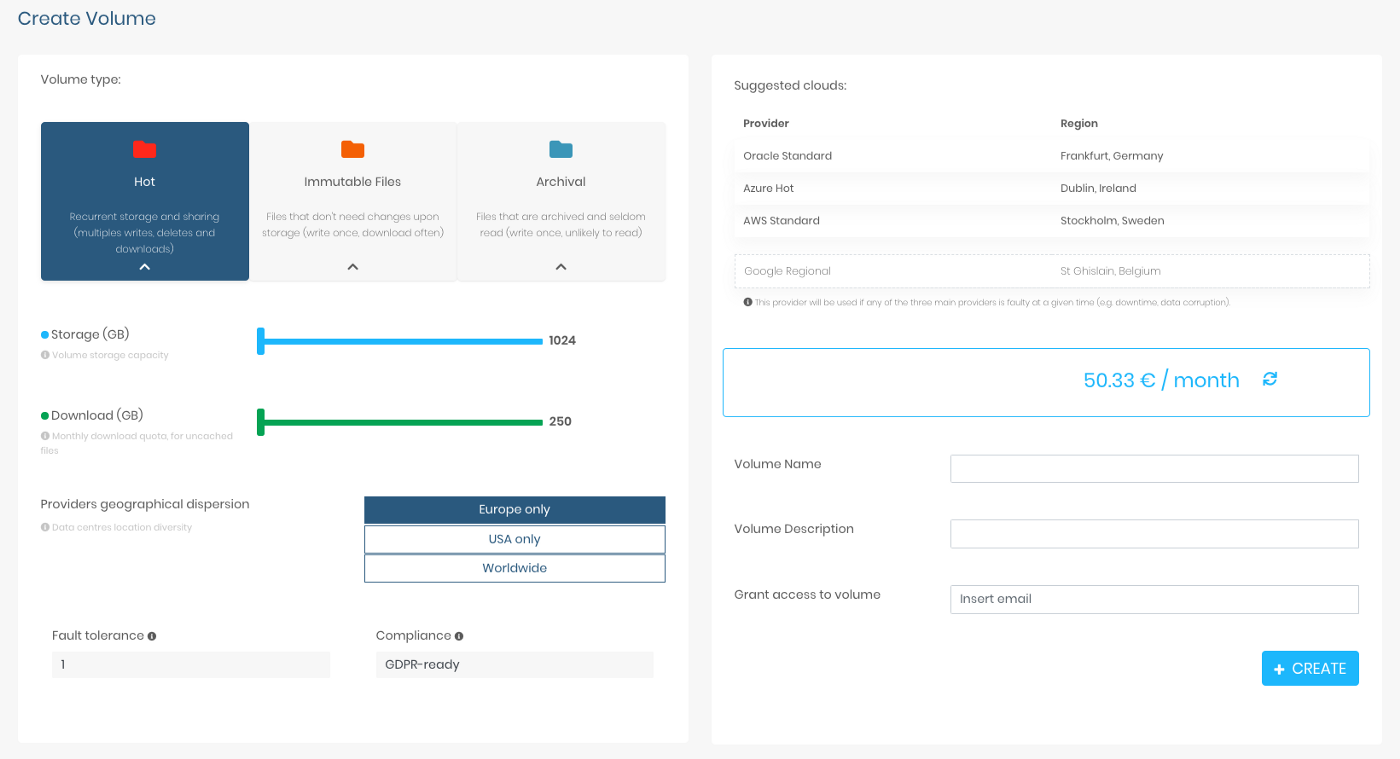Two weeks ago we launched the Private Beta of our Plataforma Dinámica de Almacenamiento. Now I invite you to join me on a guided tour around the platform, so you can grasp the concept and start envisioning all possible ways in which Vawlt can help your organisation.
I will briefly take you through the 5 topics below and I have high expectations that when you finish reading you will be a Vawlt-ninja. Please don’t let me down.
1. Vawlt users
2. Menu options
3. Creating data volumes
4. Interfaces
5. Use cases
1. Vawlt users
Before we dive in deep, let me highlight that only a user with an administration role will be able to log in to our platform and manage all things related to users and data volumes. All users can be granted access to one or more data volumes and you can access them by logging in via one of the available interfaces I will soon show you.
2. Menu options
We kept the sidebar quite simple. You have an Visión general tab, where you can get the big picture of your organisation. Here you can check things such as total number of users, total number of volumes, total monthly usage and your billing information (disabled for Private Beta). You also have a list with all the latest activity logs organisation-wide, and a list of deployments showing all the devices accessing volumes.

The second tab you see is Volumes, and this is the place to go and list all existing data volumes in your organisation. The table will show you a quick digest on the information regarding each volume, and you can get the complete details by clicking the “down-arrow” icon on the right-hand side of each table entry. I will give you more details on how to create a new volume in the next topic.

The third tab on the menu is where you can manage your organisation’s Users. You can quickly add users and list all the existing ones. For each user, the table will show you an account status: when you add a new user to your organisation, the user will have to validate the account by clicking the link he/she will receive by e-mail and setting a password to access Vawlt.
3. Creating data volumes
Bear with me for this is one of Vawlt’s key differentiating features and therefore something you will be experiencing for the first time.
The moment you hit the create volume button on the Volumes menu tab, you unleash all the power of multiple cloud providers, their various data centre locations and storage tiers. Total time to create a new volume: about 10 seconds. Yes, 10!
Imagine going directly to 1 cloud provider website and creating an account, selecting the object storage service, selecting the storage tier, selecting one storage region, creating a storage space, creating a user and giving permissions to access the storage space. Imagine all of these for 4 cloud providers. Can you picture it? Now you just need to find a way to write and read files other than you browser. Feeling tired already? I am, just by writing it. Vawlt: 10 seconds 🙌
For the Private Beta, we selected a finite number of choices you get when creating a new volume. We want you to get acquainted and to validate the concept. We will gradually extend the possibilities, so stay tuned and share your “wish list” with us. Let’s look at the choices below.

The first thing you get to select is the type of volume you want to create, based on the specific workload you envision. You have 3 options: , for data that will be frequently stored, deleted, versioned, and shared; Immutable files, for data that you store once and will not need to edit later (each file has a 30-days minimum storage duration charge); Archival, for data that you want to store but is very unlikely to be read (180-days minimum storage duration charge).
Both Hot y Immutable files have an average download time in the order of milliseconds (time to first byte), whereas the Archival can take up to 5 hours. When you open a file inside a volume, the file will be downloaded from the clouds if it’s not stored on your device’s Vawlt cache.
PRO TIP 1: We use a “least recently used” cache policy that allows your stored data to exceed your device’s cache capacity; the files you most interact with will be kept in your device, and the remaining ones are only stored in the clouds so, when you open them, said “download time” applies.
You can then choose a storage capacity for the volume, and a monthly download quota for the “uncached files” I’ve just described.
Next, you select the provider’s geographical dispersion, and the options are self-explanatory: Europe only, USA only, and Worldwide. On the right-hand side you will see the list of suggested clouds and their respective data center locations.
Every selection you make will dynamically update the monthly price of the volume you are creating so you can make an informed decision.
And that’s it, you just have to set a volume name y description, y grant access to a user. When you click “Create”, you will see a confirmation screen with a summary of your choices and when you confirm, your volume is created.
4. Interfaces
This is a power-feature of our product, and one that will save you a lot of time. And headaches! We did our best not to bring disruption to your currently IT architecture so we developed several interfaces for your devices to interact with Vawlt: file system, NFS, S3-API. Several other interfaces are on our roadmap so let us know about your specific needs.

PRO TIP 2: each volume you create can be simultaneously connected in several devices, each with the interface you decide to be the best for that specific interaction.
PRO TIP 3: you can interact with Vawlt via a command line interface (CLI), for devices where a graphic user interface (GUI) is not the best option.
5. Use cases
Here, at Vawlt, we regularly brainstorm different possible applications for our product and when we think we’ve covered a big deal of use cases, we enter a business meeting and a company comes up with a hyper-specific (borderline exotic) architecture that never crossed our mind. In those cases, our immediate reaction is always to smile because that highlights the biggest Vawlt super-power: it’s user-defined. All components of the product provide such a level of simplicity, automation, abstraction, and integration that it’s hassle-free for any company to quickly start testing and using our solution.
Now that we’ve acknowledged the enormous diversity of potential uses, let’s kick-off with some examples that might inspire you to start trying Vawlt in your own organisation:
HOT
– team files
– active legal processes
– current year’s accounting documentationIMMUTABLE FILES
– call centre calls
– medical imagery and records
– static documents (e.g. signed contracts)ARCHIVAL
– logs from switches, firewalls, etc.
– closed legal processes
– past years’ accounting documentation
I hope you have enjoyed the ride, let us know if you have questions, suggestions, comments.
If you got curious and want to try Vawlt on your own, create an account aquí.
Bruno (Co-founder, CEO)

